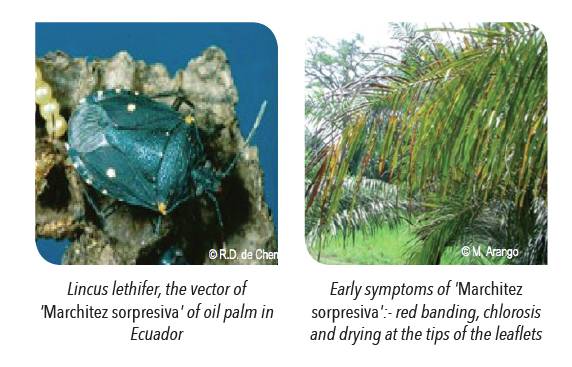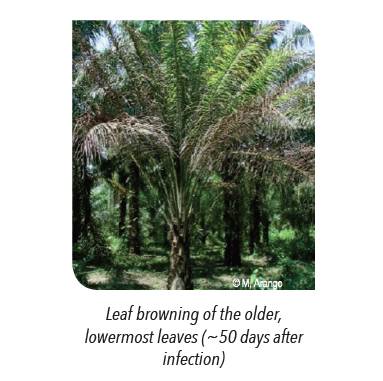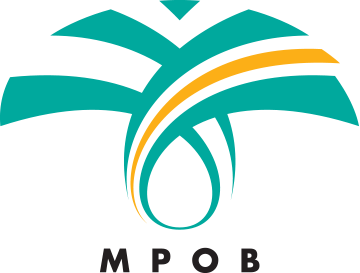General Information

Lincus lethifer is a vector of the disease ‘Marchitez sorpresiva‘ of Elaeis guineensis Jacq. and hartrort of Cocos nucifera in Ecuador. Both diseases are caused by the same pathogen, the protozoan Phytomonas staheli.
Marchitez sorpresiva or sudden wilt is one of the commonest oil palm disease in Latin America. The disease is characterised by the rotting of the palm heart. Other symptoms of the disease include i) browning of the older, lower leaves that progresses upwards to the younger leaves; ii) necrosis of freshly opened inflorescences, iii) premature nutfall of young fruits. Crown foliage may also be affected by secondary bacterial/fungal infection. Palms often die within 2-3 months after the onset of external symptoms, but this may vary depending on palm variety.
The protozoan P. staheli inhabit the sieve tubes of oil palms and coconut trees. Adults of L. lethifer carry and transmit the protozoan during feeding. L. lethifer feed on the axils of the leaf petioles. Sucking the sap of the epidermis of young leaves near the trunk. They are attracted by the aromatic volatile compounds of the inflorescences, which guide them to new palms. Adults are photophobic and disperse by night flight.
Distribution
Ecuador
Detection and Inspection
ADULT
10 mm long. Blackish-brown in colour with yellow spots on the thorax and scutellum. The lifespan of an adult is approx. one month. Oviposition rate is highest during the rainy season. The total duration of the life cycle is 3 to 3.5 months. More than 2 generations may occur per year.
NYMPHS 2 mm in length. Larval development last for 2 months and is made up of 5 instars. The imagos live a little more than a month. Imagos and immature occur together.
EGGS Laid in batches of 16 to 18 in straight rows on petioles of palms, beneath the fibrous sheaths. Nymphs hatch after 7 to 9 days.
Plant Biosecurity Division Malaysia. All consignments are subjected to inspection by the Agricultural Department prior to clearance by Customs. Germplasm material imported from high risk areas should be sent for third country quarantine before arrival onto Malaysian shores. The import of alternative host plants e.g. Astrocaryum spp. from infested areas should be enquired with DOA.

CULTURAL CONTROL AND SANITARY METHODS
Cultural control and maintaining field hygiene is crucial in controlling insect population. The pentatomid seek refuge in moist plant debris and in weeds during daytime. Treatment with acephete through trunk injection can be applied for controlling Lincus lethifer.
Further reading
- Arango, M; Pineda, B; Martinez, G and Villegas, B (2011). Consideraciones epidemiológicas y etiológicas de la marchitez sorpresiva en palma de aceite en la Zona Norte de Colombia. Palmas, 32(1): 35-44.
- Couturier, G and Kahn, F (1989). Bugs of Lincus spp. Vectors of Marchitez and Hartrot (Oil Palm and Coconut Diseases) on Astrocaryum spp. Amazonian Native Palms. Principes, 33(1): 19-20.
- Howard, F W; Moore, D; Giblin-Davis, R M and Abad, R G (2001). Insects on Palms. CABI: UK. 400 pp.
- Mariau, D (2001). The fauna of oil palm and coconut: Insect and mites pests and their natural enemies. La Librairie du CIRAD: France. 264 pp.
- Panizzi, A R (1997). Wild Hosts of Pentatomids: Ecological Significance and Role in Their Pest Status on Crops. Ann. Rev. Entomol. 42: 99-122.
- Panizzi, A R; Mcpherson, J E; James, D G; Javahery, M and Mcpherson, R M (2000). Stink bugs (Pentatomidae). in Heteroptera of Economic Importance. CRC Press: USA. p. 421- 474.
- Perthuis, B, Desmier De Chenon, R and Merland, E (1985). Revelation of the marchitez sorpresiva vector of the oil palm – the bug Lincus lethifer Dolling (Hemiptera Pentatomidae Discocephalinae). Oléagineux, 40(10): 473-476.

